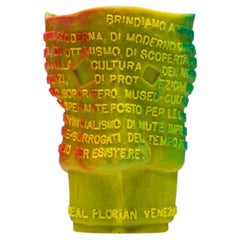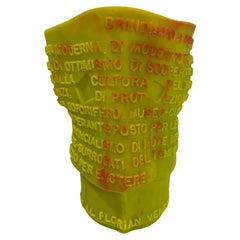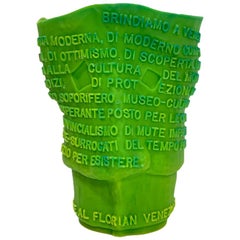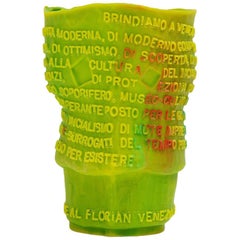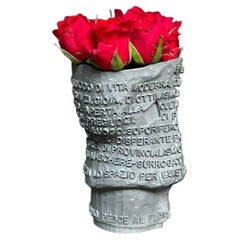Pesce Florian
1990s Italian Post-Modern Vases
Rubber
20th Century Italian Vases
Plastic
20th Century Italian Vases
Plastic
Recent Sales
1990s Italian Post-Modern Vases
Resin
20th Century Vases
Resin
1990s Italian Post-Modern Vases
Resin
20th Century Italian Vases
Plastic
20th Century Italian Vases
1990s European Post-Modern Vases
Resin
20th Century Italian Vases
Plastic
1990s Italian Mid-Century Modern Vases
Plastic
People Also Browsed
Vintage 1960s Italian Mid-Century Modern Barware
Metal
Vintage 1950s American Folk Art Carnival Art
Canvas
1990s Italian Mid-Century Modern Chandeliers and Pendants
Brass
Early 2000s Japanese Mid-Century Modern Floor Lamps
Steel
21st Century and Contemporary German Mid-Century Modern Chandeliers and ...
Metal, Iron
Vintage 1970s Mid-Century Modern Chairs
Paper
Vintage 1970s Italian Post-Modern Floor Lamps
Linen
Vintage 1960s Dutch Mid-Century Modern Wall Lights and Sconces
Metal
Vintage 1950s French Mid-Century Modern Chandeliers and Pendants
Tôle
Antique Mid-19th Century Japanese Edo Doors and Gates
Cedar
Late 20th Century Italian Mid-Century Modern Chandeliers and Pendants
Art Glass, Murano Glass
21st Century and Contemporary Portuguese Modern Side Tables
Ceramic, Clay
Vintage 1960s American Mid-Century Modern Lounge Chairs
Fiberglass
Early 2000s French Prints
Paper
Antique Early 1900s Austrian Jugendstil Planters, Cachepots and Jardinières
Metal
21st Century and Contemporary Spanish Mid-Century Modern Floor Lamps
Opal
Gaetano Pesce for sale on 1stDibs
Gaetano Pesce was of a generation of Italian architects who in the early 1960s rebelled against the industrial perfection of modernism by conceiving new furniture and objects that were at once expressive and eccentric in form; or you might say they were more like art than functionalist design.
Born in the picturesque coastal Italian city of La Spezia in 1939, Pesce was a precocious talent who could have forged a career as an artist but opted instead to go to Venice to study architecture because, as he has said, it was “the most complex of all the arts.” Rather than having new worlds opened to him at design school, however, Pesce found the rationalist curriculum oppressive in its insistence on standardization and prescribed materials and technologies.
Pesce wanted to explore the latest of both materials and technologies to create objects and buildings never before imagined, with what he called “personalities” that spoke to the issues of the day. He was keen to examine ways to diversify mass production so that each manufactured work could be distinct.
In 1964, Pesce met Cesare Cassina, of the forward-looking furniture company C&B Italia in Milan (now known as B&B Italia), for whom he would create many important designs, beginning with a collection of what he called “transformational furniture” — two chairs and a loveseat — made entirely out of high-density polyurethane foam. To make the pieces easy to ship and cost-efficient, he proposed that after being covered in a stretch jersey, they be put in a vacuum, then heat-sealed flat between vinyl sheets. Once the foam was removed from its packaging, the piece returned to its original shape — hence, the name Up for the series, which debuted in 1969.
In addition to these pieces, Pesce proposed for the collection something he referred to as an “anti-armchair,” which took the shape of a reclining fertility goddess, the iconic Donna.
Producing the piece's complex form turned out to be a technical challenge. Bayer, the foam’s manufacturer, deemed it impossible to accomplish. Pesce persisted and came up with a new procedure, demonstrating not only the designer’s key role in researching the nature and potential of new materials but also his vital importance in “doubting rules.” The Up chair and accompanying ottoman were born, and they were revolutionary in more ways than one.
In the early 1970s, Pesce began exploring one of his key concepts, the idea of the industrial originals. Employing a mold without air holes, and adding a blood-red dye to the polyurethane, he cast a bookcase that resembled a demolished wall, the rough edges of the shelves and posts resulting from fissures in the material made by trapped air.
Through his research into polyurethane, Pesce figured out a way to make a loveseat and armchair using only a simple wood frame and strong canvas covering as a mold. Since the fabric developed random folds during the injection process, the pieces were similar but not identical. Cassina named the suite of furnishings Sit Down and introduced it in 1975. By experimenting with felt soaked in polyurethane and resin, Pesce conceived I Feltri, another collection of armchairs introduced by Cassina in 1987.
Pesce went on to live a life that defied expectation and convention and along the way became one of the most seminal figures in art and design.
Find vintage Gaetano Pesce chairs, sofas, vases and more on 1stDibs.
Finding the Right Vases for You
Whether it’s a Chinese Han dynasty glazed ceramic wine vessel, a work of Murano glass or a hand-painted Scandinavian modern stoneware piece, a fine vase brings a piece of history into your space as much as it adds a sophisticated dynamic.
Like sculptures or paintings, antique and vintage vases are considered works of fine art. Once offered as tributes to ancient rulers, vases continue to be gifted to heads of state today. Over time, decorative porcelain vases have become family heirlooms to be displayed prominently in our homes — loved pieces treasured from generation to generation.
The functional value of vases is well known. They were traditionally utilized as vessels for carrying dry goods or liquids, so some have handles and feature an opening at the top (where they flare back out). While artists have explored wildly sculptural alternatives over time, the most conventional vase shape is characterized by a bulbous base and a body with shoulders where the form curves inward.
Owing to their intrinsic functionality, vases are quite possibly versatile in ways few other art forms can match. They’re typically taller than they are wide. Some have a neck that offers height and is ideal for the stems of cut flowers. To pair with your mid-century modern decor, the right vase will be an elegant receptacle for leafy snake plants on your teak dining table, or, in the case of welcoming guests on your doorstep, a large ceramic floor vase for long tree branches or sticks — perhaps one crafted in the Art Nouveau style — works wonders.
Interior designers include vases of every type, size and style in their projects — be the canvas indoors or outdoors — often introducing a splash of color and a range of textures to an entryway or merely calling attention to nature’s asymmetries by bringing more organically shaped decorative objects into a home.
On 1stDibs, you can browse our collection of vases by material, including ceramic, glass, porcelain and more. Sizes range from tiny bud vases to massive statement pieces and every size in between.
